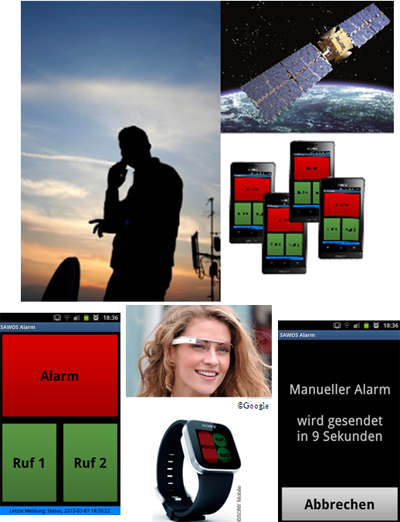
Objectives of the service
OTM / OSERA provides accessibility and connectivity for Alpine tourists and professional users through an ICT-based innovative public service.
Tourists (hikers, bikers, climbers, etc.) in all Alpine regions share the same needs when doing outdoor activities.
They require:
- Reliable, complete, updated and easily/ freely available mountain trail maps.
- The utmost level of safety when doing outdoor activities (especially in areas outside GSM coverage or bordering two countries).
- Easy, reliable, timely, and efficient access to search and rescue services in cases of emergency.
The OTM / OSERA fast track study contains explorative and piloting activities for the provision of reliable hiking maps and internet-based information with a collaborative web 2.0 approach. OTM / OSERA implements transnational integration of distress call and location service for emergencies and accidents.

Users and their needs
OTM / OSERA provides accessibility and connectivity for Alpine tourists and professional users through an ICT-based innovative public service.
The number of people doing outdoor (sports) activities (hiking, biking, climbing, etc.) in mountainous regions is continuously increasing. In addition, there is a strong trend for "free routing" through the mountains which creates new risks for personal safety and environmental damages.
The user communities for OTM / OSERA are:
- Mass market e.g. Alpine tourists e.g. hikers, bikers, climbers, etc.
- Professional market e.g. tourist organisations, event organisers, and search and rescue organisations.
- Mountaineering associations and Alpine nature park and hut operators
- GIS and mapping experts
Mass market, professional users, Alpine nature park and hut operators and mountaineering associations were involved in the OTM/OSERA fast track study.
Members of the largest mountaineering associations in Austria, Germany, and Northern Italy (Austrian, German and Italian Alpenverein and Austrian and German Naturfreunde), event organisers (http://www.bergfuehrer.com), and of the mountain rescue organisation in Austria, Germany, and Northern Italy were involved. The Alpenverein and Naturfreunde are also large operators of Alpine huts. Thus, this important user group was also directly involved in the study.
Service/ system concept
OTM / OSERA provides accessibility and connectivity for Alpine tourists and professional users through an ICT-based innovative public service.
Within the analysis of the user requirements, 6 primary services were identified:
Service 1 | Locating & Tracking Service |
Service 2 | Emergency Call Service |
Service 3 | Map Provision |
Service 4 | Advanced Communication Service |
Service 5 | Desktop Web-Access |
Service 6 | Tour Provision |
"Offline Data Provision" and "Data Transfer" are important parts of multiple services and therefore not mentioned as single services but described within corresponding services.
Additionally, 4 secondary services have been identified:
Service 7 | Geocache Data Provision |
Service 8 | Augmented Reality |
Service 9 | Social Media Link |
Service 10 | Add Photo Function |
Secondary services were not analysed in detail within the OTM/OSERA study but were used to define system requirements that allow the integration of those services at a later stage.
Space Added Value
OTM / OSERA relies on the following space assets:
- Satellite navigation data for guiding the tourists, providing the coordinates of the tracks and providing the coordinates in cases of emergency.
- Earth observation data for contributing to, establishing and maintaining the open trail map layer and for quality checking of incoming track data.
- Satellite communication to establish internet connectivity in remote areas through solar powered satellite hubs e.g. ASTRA2Connect as well as mobile satellite connectivity through Iridium for professional users.
Current Status
The team has concluded the study work including the user workshop, user needs consolidation, technical requirements definition, service definition, integrated solution design, and technical and commercial viability analysis.




